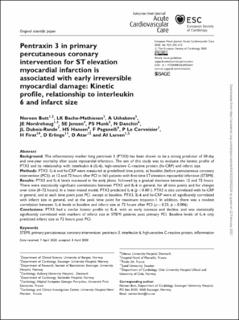| dc.contributor.author | Butt, Noreen | |
| dc.contributor.author | Bache-Mathiesen, Lena Kristin | |
| dc.contributor.author | Ushakova, Anastasia | |
| dc.contributor.author | Nordrehaug, Jan Erik | |
| dc.contributor.author | Jensen, Senn-Erik | |
| dc.contributor.author | Munk, Peter Scott | |
| dc.contributor.author | Danchin, N | |
| dc.contributor.author | Dubois-Rande, Jean-Luc | |
| dc.contributor.author | Hansen, HS | |
| dc.contributor.author | Paganelli, F | |
| dc.contributor.author | Le Corvoisier, P | |
| dc.contributor.author | Firat, H | |
| dc.contributor.author | Erlinge, David | |
| dc.contributor.author | Atar, Dan | |
| dc.contributor.author | Larsen, Alf Inge | |
| dc.date.accessioned | 2021-07-14T09:20:08Z | |
| dc.date.available | 2021-07-14T09:20:08Z | |
| dc.date.created | 2021-02-22T15:32:58Z | |
| dc.date.issued | 2020 | |
| dc.identifier.issn | 2048-8726 | |
| dc.identifier.uri | https://hdl.handle.net/11250/2764356 | |
| dc.description.abstract | Background: The inflammatory marker long pentraxin 3 (PTX3) has been shown to be a strong predictor of 30-day and one-year mortality after acute myocardial infarction. The aim of this study was to evaluate the kinetic profile of PTX3 and its relationship with interleukin 6 (IL-6), high-sensitive C-reactive protein (hs-CRP) and infarct size.
Methods: PTX3, IL-6 and hs-CRP were measured at predefined time points, at baseline (before percutaneous coronary intervention (PCI)), at 12 and 72 hours after PCI in 161 patients with first-time ST elevation myocardial infarction (STEMI).
Results: PTX3 and IL-6 levels increased in the early phase, followed by a gradual decrease between 12 and 72 hours. There were statistically significant correlations between PTX3 and IL-6 in general, for all time points and for changes over time (0–72 hours). In a linear mixed model, PTX3 predicted IL-6 (p < 0.001). PTX3 is also correlated with hs-CRP in general, and at each time point post PCI, except at baseline. PTX3, IL-6 and hs-CRP were all significantly correlated with infarct size in general, and at the peak time point for maximum troponin I. In addition, there was a modest correlation between IL-6 levels at baseline and infarct size at 72 hours after PCI (ρ = 0.23, p = 0.006).
Conclusions: PTX3 had a similar kinetic profile to IL-6, with an early increase and decline, and was statistically significantly correlated with markers of infarct size in STEMI patients post primary PCI. Baseline levels of IL-6 only predicted infarct size at 72 hours post PCI. | en_US |
| dc.language.iso | eng | en_US |
| dc.publisher | SAGE | en_US |
| dc.rights | Navngivelse 4.0 Internasjonal | * |
| dc.rights.uri | http://creativecommons.org/licenses/by/4.0/deed.no | * |
| dc.title | Pentraxin 3 in primary percutaneous coronary intervention for ST elevation myocardial infarction is associated with early irreversible myocardial damage: Kinetic profile, relationship to interleukin 6 and infarct size | en_US |
| dc.type | Journal article | en_US |
| dc.type | Peer reviewed | en_US |
| dc.description.version | publishedVersion | en_US |
| dc.rights.holder | Copyright The European Society of Cardiology 2020 | en_US |
| cristin.ispublished | true | |
| cristin.fulltext | original | |
| cristin.qualitycode | 1 | |
| dc.identifier.doi | 10.1177/2048872620923641 | |
| dc.identifier.cristin | 1892457 | |
| dc.source.journal | European Heart Journal: Acute Cardiovascular Care | en_US |
| dc.source.pagenumber | 302-312 | en_US |
| dc.identifier.citation | European Heart Journal: Acute Cardiovascular Care. 2020, 9 (4), 302-312. | en_US |
| dc.source.volume | 9 | en_US |
| dc.source.issue | 4 | en_US |

